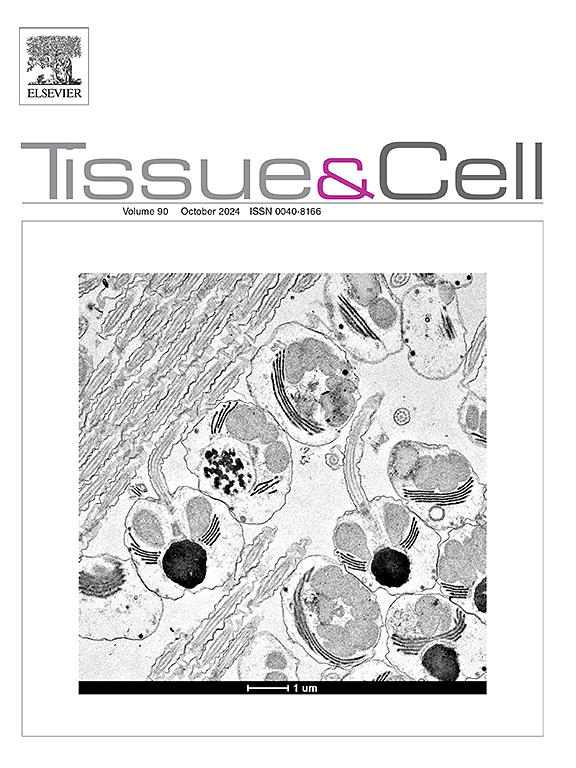Dimethyloxalylglycine regulates osteogenesis of dental pulp stem cells through PI3K/AKT signaling pathways
IF 2.7
4区 生物学
Q1 ANATOMY & MORPHOLOGY
引用次数: 0
Abstract
Background
Dental pulp mesenchymal stem cells (DPSCs) are typically cultivated in vitro under normoxic conditions, which may adversely affect their biological functions during research and treatment. Dimethyloxalylglycine (DMOG) is a small-molecule drug that has demonstrated impressive therapeutic outcomes in conditions such as osteoporosis.
Objective
However, the influence of DMOG on the osteogenesis associated with DPSCs remains inadequately understood. We propose that DMOG may significantly impact the biological functions related to osteogenesis in DPSCs when exposed to normoxic conditions.
Materials and methods
DPSCs were obtained through tissue block enzyme digestion. Tube formation experiment was conducted, quantitative polymerase chain reaction (qPCR) was employed to assess the angiogenic activity of DPSCs. Additionally, alkaline phosphatase (ALP) activity tests, alizarin red staining (ARS), qPCR and western blotting (WB) assays were utilized to evaluate the osteogenic activity of DPSCs. The proposed mechanism was confirmed through repeated experiments.
Results
DMOG significantly influences the osteogenic functions of DPSCs under normoxic conditions. Our findings further confirm that DMOG stimulates the phosphatidylinositol 3-kinase (PI3K)/Protein kinase B (AKT) signaling pathway in DPSCs via phosphorylation. Inhibition of this pathway can partially impede the biological effects of DPSCs related to osteogenesis and angiogenesis.
Conclusion
We have addressed the gap in understanding the effect of DMOG on the osteogenesis of DPSCs. Unlike previous studies that examined the regulation of osteogenesis in stem cells by DMOG, our findings suggest that a lower dose of DMOG is sufficient to enhance the osteogenesis of DPSCs. This could represent a promising strategy for cellular therapy in bone regeneration.
二甲基氧草酰甘氨酸通过PI3K/AKT信号通路调控牙髓干细胞成骨
牙髓间充质干细胞(DPSCs)通常是在常温条件下体外培养的,在研究和治疗过程中可能会对其生物学功能产生不利影响。二甲基氧基酰甘氨酸(DMOG)是一种小分子药物,在骨质疏松症等疾病中表现出令人印象深刻的治疗效果。然而,DMOG对DPSCs相关成骨的影响尚不清楚。我们认为DMOG可能会显著影响DPSCs在常压条件下与成骨相关的生物学功能。材料和方法采用组织阻断酶切法获得sdpsc。采用成管实验,定量聚合酶链反应(qPCR)评价DPSCs的血管生成活性。此外,采用碱性磷酸酶(ALP)活性、茜素红染色(ARS)、qPCR和western blotting (WB)检测DPSCs的成骨活性。通过反复实验证实了所提出的机理。结果常温下dmog对DPSCs成骨功能有显著影响。我们的研究结果进一步证实,DMOG通过磷酸化刺激DPSCs中磷脂酰肌醇3-激酶(PI3K)/蛋白激酶B (AKT)信号通路。抑制该通路可部分阻碍DPSCs与成骨和血管生成相关的生物学作用。结论DMOG对DPSCs成骨作用的研究已经填补了空白。与以往研究DMOG对干细胞成骨的调节不同,我们的研究结果表明,较低剂量的DMOG足以促进DPSCs的成骨。这可能代表了一种很有前途的骨再生细胞治疗策略。
本文章由计算机程序翻译,如有差异,请以英文原文为准。
求助全文
约1分钟内获得全文
求助全文
来源期刊

Tissue & cell
医学-解剖学与形态学
CiteScore
3.90
自引率
0.00%
发文量
234
期刊介绍:
Tissue and Cell is devoted to original research on the organization of cells, subcellular and extracellular components at all levels, including the grouping and interrelations of cells in tissues and organs. The journal encourages submission of ultrastructural studies that provide novel insights into structure, function and physiology of cells and tissues, in health and disease. Bioengineering and stem cells studies focused on the description of morphological and/or histological data are also welcomed.
Studies investigating the effect of compounds and/or substances on structure of cells and tissues are generally outside the scope of this journal. For consideration, studies should contain a clear rationale on the use of (a) given substance(s), have a compelling morphological and structural focus and present novel incremental findings from previous literature.
 求助内容:
求助内容: 应助结果提醒方式:
应助结果提醒方式:


